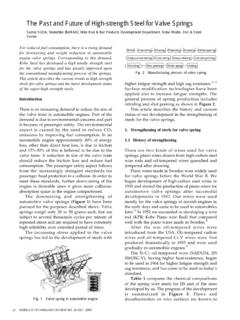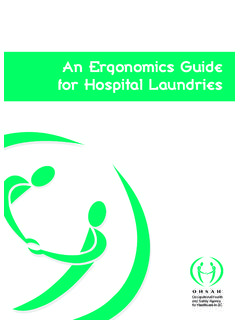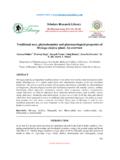Transcription of Survey of molds, yeast and Alicyclobacillus spp. …
1 Survey of molds, yeast andAlicyclobacillusspp. from a concentrated apple juiceproductive processBeatriz de C ssia Martins Salom o1, Chalana Muller2, Hudson Couto do Amparo2,Gl ucia Maria Falc o de Arag o31 Departamento de Engenharia Qu mica, Universidade Federal do Rio Grande do Norte, Natal, RN, cleo de Biotecnologia, Universidade do Oeste de Santa Catarina, Videira, SC, de Engenharia Qu mica e Engenharia de Alimentos,Universidade Federal de Santa Catarina, Florian polis, SC, : July 4, 2012; Approved: September 9, and molds may spoil and/or contaminate apple juice either by direct microbial action or indi-rectly by the uptake of metabolites as off-flavours and toxins. Some of these microorganisms and/ormetabolites may remain in the food even after extensive procedures. This study aim to identify thepresence of molds (including heat resistant species) andAlicyclobacillusspp., during concentratedapple juice processing. Molds were isolated at different steps and then identified by their macro-scopic and microscopic characteristics after cultivation on standard media at 5, 25 and 37 C, during 7days.
2 Among the 19 isolated found, 63% were identified asPenicilliumwith 50% belonging to With regards to heat resistant molds, the speciesNeosartorya fischeri,Byssochlamys fulvaand also the genusEupenicilliumsp.,Talaromycessp. andEurotiumsp. wereisolated. The thermoacidophilic spore-forming bacteria were identified asA. acidoterrestrisby a fur-ther investigation based on 16S rRNA sequence similarity. The large contamination found indicatesthe need for methods to eliminate or prevent the presence of these microorganisms in the processingplants in order to avoid both spoilage of apple juice and toxin words: concentrated apple juice , Alicyclobacillus acidoterrestris, heat resistant mold,Penicillium juice belongs to the most frequently consumedtypes of fruit juices worldwide (53). The necessity to imple-ment and optimize fast and efficient methods for qualitycontrol appears as a consequence of this use, and should bedone throughout the whole processing procedure, begin-ning in the orchard (Silvaet al.)
3 , 1997).Some species of molds may cause serious postharvestdiseases in apples (Kupferman 1986). Among them,Penicillium expansumis reported as being responsible formajor decay on apples. Studies have shown that this mold isfound in soil, on plant surfaces, in dump tank or flume wa-ter (Spotts and Cervantes, 1993), in contaminated woodenbins (Sanderson and Spotts, 1995) and in the atmosphere(Amiri and Bompeix, 2005). Furthermore, this mold has theability to produce patulin (Doores, 1983), a mycotoxin re-ported to cause oxidative damage to the DNA in humancells, which plays a role in mutagenesis and cancer initia-tion (Liuet al., 2003).Heat resistant molds (HRM) are among the microor-ganisms of great importance in the spoilage of heat-pro-cessed fruit juices, such as apple juice . Representativespeciesarefoundinthegenera Byssochlamys,Neosartorya,Eupenicillium,T alaromyces, (Murakamietal., 1998; Sureshet al., 1996; Tournas, 1994)Eurotium(Splittstoesseret al., 1989; Yildiz and Coksoyler, 2002)andPaecilomyces(Pe aet al.
4 , 2004; Pieckov and Sam-Brazilian Journal of Microbiology 45, 1, 49-58 (2014)Copyright 2014, Sociedade Brasileira de MicrobiologiaISSN correspondence to Salom o. Departamento de Engenharia Qu mica, Universidade Federal do Rio Grande do Norte, 59072-970 Natal, RN,Brazil. E-mail: Paperson, 2000). Some of the heat resistant molds can causeboth spoilage of fruit products and produce toxic andsometimes carcinogenic compounds (Tournas, 1994;Ugwuanyi and Obeta, 1999). Alicyclobacillus acidoterrestrisis a thermoacido-philic spore-forming bacterium (ATSB) which is able tospoil acidic juices (Bah eci and Acar, 2007; Chenet al.,2006; Eguchiet al., 1999; Groenewaldet al., 2009;McKnightet al., 2010; Yamazakiet al., 1996). SpoilagebyAlicyclobacillushas become a problem for the applejuice industry and effective solutions should be found tocontrol its development. The spoilage generally is mani-fested as an off-flavour and an off-odour of a medicinal orchemical nature due to the formation of guaiacol andhalophenols (Chang and Kang, 2004; Chenet al.
5 , 2006;Yamazakiet al., 1996), leading to consumer rejections(Zierleret al., 2004).Apples rejected by the rigid selection criteria for thefresh fruit consumption market are used for juice process -ing. Microorganisms mentioned above may be presentleading to a health risk for consumers and/or high economiclosses due to juice deterioration. This study aims to surveymolds (including heat resistant ones), yeast andAlicyclobacillusspp. in a concentrated apple juice manu-facturing and MethodsSamplingSamples were obtained at different stages from a con-centrated apple juice processing plant in Brazil. The sam-ples (collected in the off-season period) were taken at thefollowing steps: apples in the reception (A); washed apples(WA); wash water (W) (recycled in a close system); must(M); bagasse (B); before pre-concentration (BPC); afterpre-concentration (APC); enzymatic treatment (ET); be-fore ultra-filtration (BUF); after ultra-filtration (AUF); be-fore concentration (BC); after concentration (AC) and finalproduct (FP).
6 All samples were collected (approximately250 mL per step) in sterile sampling containers, on the sameday. Then they were stored under refrigeration using reus-able ice for transport during 6 h. In the laboratory, the con-tainers were place in a refrigerator and the samples wereanalyzed within 24 h. Thirty samples of apples were col-lected randomly to represent the real state of the fruits. Dur-ing the analysis, pieces of different apples were mixed tomaintain the randomness of the from different part of the process were testedin order to provide comprehensive data on the occurrenceof molds and yeasts, heat resistant molds (HRM) andAlicyclobacillusat different stages of processing. Two vis-its were made in the processing plant and the aforemen-tioned samples was taken in each one. Figure 1 presents theflow diagram of the production process indicating the sam-ple and yeast enumerationMolds and yeasts were detected by diluting 25 g ofapples and bagasse samples in 225 mL of peptonatewater, followed by a two minute homogenization in astomacher (ITR, Model 1204).
7 juice and liquid sampleswere just diluted in water (10 mL of the sample in 90 mL ofthe diluent). Subsequently, serial dilutions were made us-ing peptonate water and then samples were plated induplicate, using Potato Dextrose Agar (PDA, Biolife , Mi-lan, Italy) acidified to pH with 10% tartaric acid solu-tion. All plates were then incubated at 25 C and colonieswere counted after 3-5 days. Theresults were expressed asCFU/mL or CFU/g, depending on the kind of sample (Silvaet al., 1997).Heat resistant molds enumerationApples (previously mixed in a sterile blender) andsamples of bagasse were placed each one in a sterile plasticbag and homogenized (100 g of the samples plus 100 mL ofsterile distillated water) in a stomacher (Pro-analise ,Model Boit-Sto1) for 4 min. Two 50 mL portions of ho-mogenized samples were then transferred to sterile testtubes and heat shocked in a water bath (Tecnal , Model184 C) at 80 C for 30 min. Concurrently, 50 mLsamples of concentrated apple juice (70 Brix) were dilutedwith 50 mL of sterile distillated water and then also heatedshocked.
8 Liquids samples (35 Brix or less) were analyzedwithout any previous dilution and two 50 mL aliquots ofeach sample were subjected to the same heat treatment pre-viously described. Samples Brix was measure in a refra-tometer (AR200 Reichert, USA). After heating, duplicatesamples of 50 mL were cooled and each one was combinedwith 100 mL of acidified (pH ) PDA (double agar con-centration) supplemented with 50 mg/L of rose bengal and4 mg/L of cloranfenicol. Subsequently, samples were dis-tributed in eight Petri plates which were placed in plasticbags and sealed to prevent drying. The incubation was per-formed at 30 C for up to 30 days. Most viable ascosporesgerminated and formed visible colonies within 7 to 10 days(Beuchat and Pitt, 2001). The results were expressed ascfu/mL or cfu/g, depending on the kind of identificationThe mold identification was made by macroscopicand microscopic observations using identification keys asdescribed by Pitt and Hocking (Pitt and Hocking, 1999).
9 Each strain isolated on PDA was transferred to MEA (MaltExtract Agar) and CYA (Czapek yeast Extract Agar) andG25N (25% Glycerol Nitrate Agar) media in duplicate tri-als. Cultures were grown on these three standard media at25 C for 7 days. Those inoculated on CYA was addition-ally incubated at 5 C and 37 C for the same period. Fur-thermore, Czapek agar with 20% sucrose (CY20S) wasprepared to help in the identification of genera suspected tobe xerophilic. After incubation, the diameters of macro-50 Salom oet colonies from the underside were measured andmacroscopic characteristics such as color, texture and exu-dates, were analyzed for each colony. Microscopic struc-tures were investigated with a microscopic (Bioval ) byusing lactofuchsin stain or lactophenol fungal stain(Cotton blue). Yeasts were not identified in this study; onlymolds were identified (heat resistant or not).In addition, this investigation identified the moldpresent in a storage apple (SA) with visual signs of bluemold invasion.
10 For this, a colony of mold from an applewere scraped and transferred to PDA and incubated for 5days at 25 C. After the isolation, the strain was sent toAndr Tosello Foundation (Campinas, SP, Brazil) for fur-ther identification and to be deposited at the Collection ofTropical Cultures (CCT).Alicyclobacillusisolation and enumerationThe isolation and enumeration ofAlicyclobacillusspp. (ATSB) was realized according to Eguchiet order to count ATSB, samples of concentrate juicewere diluted prior to analysis (10 mL of juice in 90 mL ofsterile distilled water). The other liquid samples (10 mL)were diluted in 90 mL of BAT (Bacillus alicycloterrestris)broth. Samples of apples and bagasse (25 g) were blendedwith 225 mL of BAT broth in a stomacher for 2 min. The di-luted samples were heated shocked at 80 C for 10 min,cooled at 40-45 C and their aliquots were plated on BATagar by the pour plate technique. All plates were incubatedat 50 C for 4 days (plates were monitored for up to 10days).














